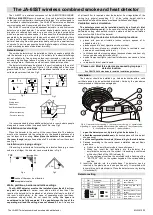
9
Cut a 9" (23 cm) length of the red enamel-coated wire.
To wind L1, "sew" the long end of the wire through the core 11 times, spacing the turns as shown in
the left-hand drawing of Figure 4.
Each pass through the core counts as one turn.
Leave at least 1/2" (12
mm) of extra wire for each lead, and trim off the excess.
Hold L1 as shown in Figure 4. Verify that lead 1 of L1 terminates on the top side of the core and lead
2 terminates on the bottom.
This winding
sense
(or direction) is required to match the pads provided for L1
on the PC board.
Make sure that the turns of L1 are evenly spaced, and that they occupy about 80% of the core. The
winding must look identical to Figure 4, with exactly 11 turns.
(Always count toroid turns on the
inside
of
the core to make sure you're counting passes
through
the core.)
i
About 90% of all problems with kits are caused by toroid leads that are not prepared
properly.
We've made it as easy as possible by supplying "Thermaleze" heat-strippable enamel-coated
wire, but you'll need to do the rest. If you read and follow these instructions carefully, you'll avoid possible
frustration, troubleshooting, and repair charges.
The goal in preparing toroid leads is to (1) remove
ALL
of the enamel coating on the leads; (2) tin the leads
so that a clean solder joint will result. Leads must be tinned up to the edge of core (the core itself is non-
conductive). Review Figure 4, which shows the part of the leads to be stripped and tinned.
If you have a padded vise (such as a Panavise), clamp L1 into it with its leads horizontal, ready for
heat-stripping and tinning. (Don't over-tighten the vise as this might crack the toroid core.) If you don't
have a vise, lay L1 on a flat surface with one lead bent upwards slightly.
Melt a very small amount of solder (a "blob") onto your iron tip, then place the tip and the hot solder
in contact with the toroid lead, about 1/4" (6 mm) away from the core. If the iron is hot enough, you should
see the insulation bubble and start to vaporize after 4 to 6 seconds. Remove the iron when this occurs.
Clean the iron tip completely using a damp sponge. Then hold it back up to the lead to clean off any
residual solder. Use solder wick if necessary.
Examine the lead closely using a magnifying glass; you should see bare copper wire where the enamel
was removed. If any enamel coating remains, repeat the heat-stripping procedure. An alternative is to use
sandpaper.
The lead must be free of all enamel before continuing.
Tin the lead by applying a small amount of fresh solder. The solder should appear clean and shiny. If it
looks dull or is not adhering very well to the bare lead, repeat the heat-stripping procedure.
Prepare the other lead of L1 in the same manner.










































